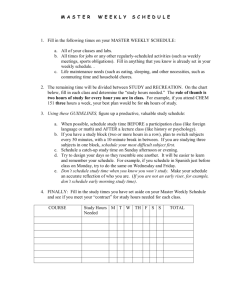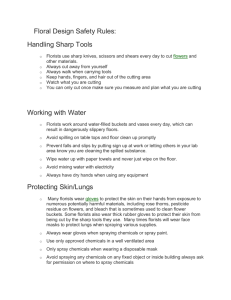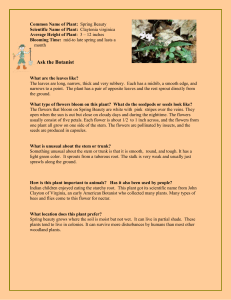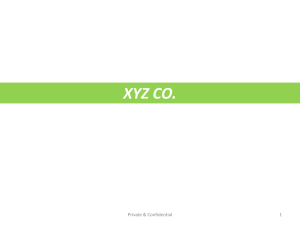The University of Georgia Locally Grown Cut Flowers Market Analysis
advertisement
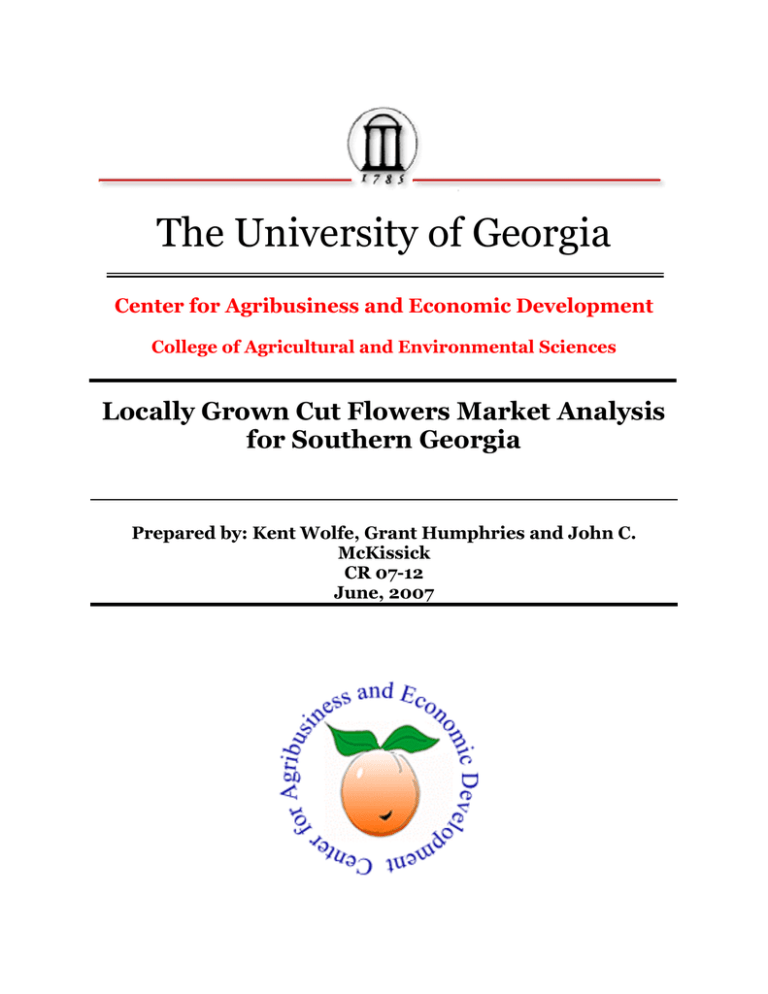
The University of Georgia Center for Agribusiness and Economic Development College of Agricultural and Environmental Sciences Locally Grown Cut Flowers Market Analysis for Southern Georgia Prepared by: Kent Wolfe, Grant Humphries and John C. McKissick CR 07-12 June, 2007 TABLE OF CONTENTS Introduction . . . . . . . . . . . . . . . . . . . . . . . . . . . . . . . . . . . . . . . . . . . . . . . . . . . . . . . . . . . . . . . . . 1 Survey Area . . . . . . . . . . . . . . . . . . . . . . . . . . . . . . . . . . . . . . . . . . . . . . . . . . . . . . . . . . . . . . . . . 1 Survey Results . . . . . . . . . . . . . . . . . . . . . . . . . . . . . . . . . . . . . . . . . . . . . . . . . . . . . . . . . . . . . . . 2 Seasonality . . . . . . . . . . . . . . . . . . . . . . . . . . . . . . . . . . . . . . . . . . . . . . . . . . . . . . . . . . . . . . . . . . . 2 Organically Grown Flower Market . . . . . . . . . . . . . . . . . . . . . . . . . . . . . . . . . . . . . . . . . . . . . . . . 3 Distribution . . . . . . . . . . . . . . . . . . . . . . . . . . . . . . . . . . . . . . . . . . . . . . . . . . . . . . . . . . . . . . . . . . 4 Marketing . . . . . . . . . . . . . . . . . . . . . . . . . . . . . . . . . . . . . . . . . . . . . . . . . . . . . . . . . . . . . . . . . . . . 4 Marketing to Florists . . . . . . . . . . . . . . . . . . . . . . . . . . . . . . . . . . . . . . . . . . . . . . . . . . . . . . . . . . . 6 Flowers in Demand . . . . . . . . . . . . . . . . . . . . . . . . . . . . . . . . . . . . . . . . . . . . . . . . . . . . . . . . . . . . 7 Conclusion and Demographics . . . . . . . . . . . . . . . . . . . . . . . . . . . . . . . . . . . . . . . . . . . . . . . . . . . 9 Introduction A greenhouse producer in south Georgia was interested in exploring the potential for converting his greenhouses into a cut flower operation. The producer has a number of greenhouses that produce vegetable plants for transplanting. However, the market for vegetable transplants is changing as producers grow and need larger suppliers. As a result, there is a need to find a new product to produce in the greenhouses to keep the business viable. Using the internet yellow pages, online florist directories, and Select Phone Software, a list of 100 florists in south Georgia and north Florida was compiled for this project. Originally, the study targeted florists located within a fifty miles radius of Grady County but was expanded to include Macon and Columbus, Georgia. Table 1 presents a list of the represented cities, the number of identified florists, and number of completed interviews by city. The data was collected using a telephone survey over a two month period, February and March. Only those florists that indicated they would be willing to purchase locally grown flowers were interviewed, those that were not willing to purchase locally grown flowers were thanked for their time and dismissed. Survey Area Table 1 presents the number of florists identified in seven (7) cities in south and central Georgia and northwest Florida. Table 1 CITY Albany CITIES SELECTED FOR FLORIST SHOP PHONE SURVEY INTERVIEWS NUMBER QUESTIONNAIRE Percent of All CONTACTS REFUSED Responses OUT OF BUSINESS 25 9 21.95% 20 15 5 1 2.44% 3 1 Valdosta 10 3 7.32% 7 3 Columbus 29 5 12.20% 17 7 Thomasville 6 3 7.32% 4 0 Tallahassee 43 11 26.83% 21 11 1 9 21.95% 119 41 100% Bainbridge Macon - Total 1 72 37 Survey Results It is important to note that 90% of all florists contacted indicated they would consider buying and reselling locally grown fresh cut flowers. The respondents were then asked why they would consider purchasing locally grown flowers. The following outlines the most frequently mentioned responses: • The majority ( 63 %) indicated that buying locally grown cut flowers would be helpful to local entrepreneurs. • In addition, 58% would buy from local growers because of reduced shipping fees. • One-third (32%) reported that purchasing from a local producer would provide them more control over the product and transactions would be timelier. • A quarter of the respondents ( 26%) felt that dealing with local grower would be less of a hassle and/or expected a fresher product would be available. The ten percent of florists that indicated they would not consider purchasing cut flowers from local farmers cited concerns with quality and price. One firm indicated they had a less than satisfactory experience in the past with a local grower. Additionally, they currently had an ample list of suppliers elsewhere. They also pointed to past experience where growers would “come and go” were never a reliable source due to their inconsistent quality, initially to meet timelines, and unreliability . It appears that the internet has entered the market with one firm reporting they met all of their flower needs by purchasing products over the internet. Seasonality Florists revealed that their busiest season for cut flowers begins in the middle of winter with Valentine’s Day and continues into the spring culminating with high school proms and graduations. The summer sees increased demand for cut flowers for weddings. Ninety-one (91%) of the respondents indicated most of their business occurred in the spring of the year. This suggests that potential cut flower producers need the ability to produce flowers in a controlled environment greenhouse space, to supply flowers during this season. When quizzed about the peak season for exotic flowers, most respondents demonstrated a lack of knowledge of the exotic cut flowers market or season. Nearly half of the florists (46.2%) said the season for exotics was no different and 40.6% admitted they had no knowledge of exotics flowers. Several florists said their exotic flower experience consisted of special order purchasing of orchids for spring graduation and weddings. 2 Table 2 WHAT SEASON OF THE YEAR DO YOU SELL THE MOST CUT FLOWERS (Multiple Responses) Fall Winter 19% 75% Spring 91% Summer Other 11% 11% Is There a Different Peak Season for Exotic Flowers Yes No Did Not Know 15.6% 46.2% 40.6% Organically Grown Flower Market Given the popularity of the organic industry, it is was deemed to be important to investigate the organic market for cut flowers by florists. There appears to be some interest by florists in purchasing organic flowers. One-third of the responding florists indicated they would purchase organic flowers if available. A similar percentage would not purchase organic flowers while another third was undecided. Just over a quarter of those that respond to the question inquiring into paying a premium for organic flowers indicated they would pay a premium. The respondents did not provide any premium estimates. The perceived market for organically grown flowers appears to be with the florists and not the end consumers as less than 10% of the florists responding to this series of questions believe there is a viable market for organically grown flowers. Table 4 RESPONDENTS VIEW OF ORGANICALLY GROWN FLOWERS Would You Purchase Organic Flowers? Would You Pay a Premium Price ? Yes No Dnk Total Yes No Dnk Total 13 13 8 34 4 9 5 18 33.5% 33.5% 33.5% 22.2% 50.0% 27.8% What Price For Organic Grown? Is There a Viable Market? Yes No Dnk Total Yes No Dnk Total 0 0 3 3 2 21 4 27 - - - - 7.4% 77.8% 14.8% 3 Distribution It is important to supply customers in a manner and time when it is convenient for them. The florists prefer to have their flowers delivered to them in the morning and they pay the shipping. Most florists prefer to have their flowers delivered in bundles. Table 5 PACKAGING SIZE, DELIVERY TIME AND VOLUME Do You Prefer Delivery or pick up? Delivery PickUp 26 86.5% Other 4 Total Who Pays for Shipping? Florist 30 13.3% 0 Grower Other Dnk Total 24 6 0 0 30 80% 20% - - Most Convenient Volume to Purchase Most Convenient Time to Receive Mornings Afternoon Total 58% 14% 30 Stem 2 6.7% Bundle Box All Total 17 5 6 30 56.7% 16.7% 20.0 Marketing The selections by respondents on this question was split approximate into thirds .First choice (33.3%) was floor stands, followed shelf displays (30.5%). But 27.8% of the chose options other than those listed above and made suggestion literally outside the box such as using brochures, the sprint phone book Cooler displays, display ads at the local hospital, and promotional phone calls. Others responded that they would use all the above suggestions. A few responded that they had no idea. Table 6 The Most Effective Means of Promoting Cut Flowers PROMOTIONAL MATERIAL NUMBER OF RESPONSES PERCENT OF TOTAL Floor Stand 12 33.3 Shelf Display 11 30.5 Other 10 27.8 Table 7 19.4 Front Counter 6 16.7 Poster 5 13.9 Did Not Know 3 8.3 4 Banners 3 8.3 Window Clings 1 2.8 Ceiling Banner 1 2.7 When ask directly about advertising locally grown flowers, 67% indicated they would (Table 7). This is encouraging, as consumers will be made aware that they can help support local producers by shopping at the florist displaying locally grown flowers. Table 7 WOULD YOU CONSIDER ADVERTISING LOCALLY GROWN CUT FLOWERS ? Yes No Don’t know 67% 11% 5% The respondents were then asked which is the most effective way of promoting and advertising locally grown flowers. There were numerous responses that included window advertisements, business cards, newspapers, radio, tv, arrangements in display coolers, word of mouth, posters with pictures, the florists’ internet web sites, and phone books. When asked, “What is the best way to inform florists of new flower product,” the respondents provided a number of answers. The most frequently mentioned response was to use direct mail. Thirty-nine percent of the florists indicated a producer should use direct mail followed by providing samples (28%) and radio commercials (22%) as the best ways advertise new producers. Table 8 WHAT IS THE BEST WAY TO INFORM FLORISTS OF NEW FLOWER PRODUCTS? Direct mail 39% Samples 28% Radio commercials 22% TV commercials 17% Set up personal interview 11% Catalog advertisements 5% Other 33% 5 Marketing to Florists One of the major obstacles associated with marketing is how to communicate with and get your product in the hands of potential customers. According to the florists, providing them with sample products is the most effective way to market locally grown flowers. Two-thirds of the respondents wanted samples of the product before they would consider adding products or a new vendor. Table 9 WHAT IS THE BEST WAY TO ENCOURAGE SOMEONE TO CARRY NEW FLOWERS AND PRODUCTS? Provide free samples 64% Discounts 44% Guarantees 25% Over forty percent of the florists suggested that providing a discount would entice them to carry new flowers and work with potential vendors. The florists also mentioned that a vendor should offer a guarantee to ensure a quality product. One respondent asked to be taken out to lunch. To further explore the possibility of marketing locally grown flowers, the florists asked if they would be willing to participate in a test market. The test market would provide potential markets to producers and new flowers and suppliers to florists. Nearly two-thirds (60%) of the florists interviewed agreed to participate in a test market project. This is encouraging ,as flower producers would have access to actual businesses which market their flowers. Table 10 WOULD YOU PARTICIPATE IN TEST MARKET Yes No Don’t Know Number 20 7 7 Percent 60% 20% 20% 6 Flowers in Demand Florists were asked to name three or four varieties of cut flowers they would most likely purchase from local producers. Table11 presents the variety , market price and annual purchase volume of these flowers. Table 11 VARIETY L0CALLY GROWN CUT FLOWERS REQUESTED BY FLORIST UNIT FREQUENCY NUMBER COST ANNUAL ANNUAL Gypsophila Gypsophila Box Box Weekly Weekly 10 5 $7.00 $8.75 VOLUME 520 260 DOLLAR $3640.00 $2275.00 Carnation Carnations Carnations Carnations Carnations Carnation Carnations Carnations Box Stem Box Stem Stem Stem Stem Stem Weekly Weekly 40week Weekly Weekly Weekly Weekly Weekly 2 100 200/Box 300 1000 200 1000 400 $5.95 0 $0.80 $0.26 $0.35 $.25 0 0 104 5000 40 15600 52000 11000 0 0 $618.00 0 $6,400.00 $4,056.00 $18,200.0 $2750. 0 0 Daisy Daisy Daisy Daisy Daisy Daisy Daisy Daisy Box Box Box Box Box Box Box Box Weekly Weekly Weekly Weekly Weekly Weekly Weekly Weekly 10 10 40 40 2 12 22 1 0 $2.50 $2.50 $2.50 6.50 $2.45 $2.00 $49.00 5000 520 2080 2080 104 624 1144 52 0 $1,300.00 $5,200.00 $5,200.00 $676.00 $624.00 $2288.00 $2548.00 Gerber daisy Gerber daisy Gerber daisy Box Box Stem Weekly Weekly Weekly 5 2 168 $8.95 $5.00 $.95 275 104 8736 $2461.25 $520.00 $8299.00 Delphinium Delphinium Box Box Weekly Weekly 2 3 $6.95 $8.95 104 156 $722.80 $1396.20 Roses Roses Roses Roses Roses Roses Stem Stem Stem Stem Stem Stem Weekly Weekly Weekly Weekly Weekly Weekly 25 100 1000 500 500 500 .89 0 $1.25 $.60 .6 0 1300 5200 52000 26000 26000 0 $1187.00 0 $65,000.00 $9360.00 $9360.00 0 Mums Mums Stem Stem Weekly Weekly 25 100 $0.32 1300 5200 $3,250.00 $1,664.00 7 Table 11 - Continued L0CALLY GROWN CUT FLOWERS REQUESTED BY FLORIST VARIETY UNIT FREQUENCY NUMBER COST ANNUAL ANNUAL VOLUME DOLLAR 312 104 26000 104 $1,560.00 $364.00 $28,600.00 $722.80 Gladiolus Gladiolus Gladiolus Gladiolus Gladiolus Box Box Box Stem Box Weekly Weekly Weekly Weekly 6 2 500 2 $7.50 $5.00 $3.50 $1.10 $6.95 Iris Iris Iris Iris Box Box Box Box Weekly Weekly Weekly Weekly 10 10 2 5 $8.50 $8.95 $6.95 $6.00 520 520 104 260 $4,420.00 $2461.25 722.80 $1560.00 Larkspur Larkspur Box Box Weekly Weekly 3 10 $7.95 $5.50 156 520 $1240.20 $2,860.00 Snapdragon Snapdragon Snapdragon Box Box Box Weekly Weekly Weekly 10 2 2 $8.95 $6.50 $6.50 520 104 104 $4,654 $676.00 $676.00 Snapdragon Sun Flower Box Box Weekly Weekly 10 2 $7.00 $9.95 520 1104 $3640.00 $1034.80 Zinnia Zinnia Day lilies Statica Box Box Box Box Weekly Weekly Weekly Weekly 0 4 10 2 $5.95 $4.00 $4.00 $5.95 0 208 0 104 0 $832.00 0 $618.00 Roses, daisies, and carnations top the list of the most requested locally grown cut flowers. All the florists preferred to receive flower deliveries on a weekly basis and want them packaged in bundles. Among the 14 requested flowers, most florists wanted the roses delivered and priced by stem. A few florists received mums, gerber daisy and gladiolus by the stem. The annual volume figures are based on stem counts. The most frequently purchased flowers are daisies which were purchased by eight of the florists and totaled 138,624 daisies annually. Roses were the second most popular flows with six florists purchasing a total of 110,550 stems annually. Roses are followed by carnations with nearly 100,000 stems bought annually among eight florists. A price comparison (Table 12) provides insight into flower prices on a per stem basis. Carnations and mums received the lowest price per stem at $.29 and $.37, respectively. gladiolus and gerber daisies bring the highest price per stem of $1.10 and $.95, respectfully. 8 Table 12 presents average price per unit paid by florists for specific flower varieties. Table 12 FLOWER VARIETY BUNCHES/BUNDLE Gypsophila STEM $7.23 Carnation $.29 Daisy $3.08 Gerber Daisy $6.98 Delphinium $7.95 $.95 Roses $.67 Mums $.37 Gladiolus $5.74 Iris $7.60 Snapdragons $7.18 Zinnia 4.98 $1.10 CONCLUSION AND DEMOGRAPHICS: The greatest cut flower demand season begins with Valentine week, placing the peak demand season in the middle of the winter, and continues until after Mothers Day in May. Potential cut flower operators should be encouraged with 90% of the responding florists indicating they would consider selling locally grown fresh cut flowers. Most felt local growers could produce and deliver a fresher product with a longer shelf life and lower freight and handling costs. A cut flower producer should expect to deliver bundled products in the morning and set the price of their products to cover the cost of delivery. Nearly 70% of the florists were willing to assist a new local grower with advertising new products and use their existing store fixtures (i.e., floor stands, cooler, and shelf displays) to promote locally grown flowers. A number of the florists indicated that producers might consider making a promotional phone call to area florists as well as placing displays with their institutional customers such as hospitals. Other florists suggested that a new producer utilize newspaper, radio and television advertisements piggy-backing on the shop operators advertising efforts. The florists interviewed for this project felt the best way to inform florists of new products or a new producer would be through direct mail (39%) and the internet. Two-thirds of the florists encouraged the use of sample products to entice potential customers. 9 The Center for Agribusiness and Economic Development The Center for Agribusiness and Economic Development is a unit of the College of Agricultural and Environmental Sciences of the University of Georgia, combining the missions of research and extension. The Center has among its objectives: < To provide feasibility and other short term studies for current or potential Georgia agribusiness firms and/or emerging food and fiber industries. < To provide agricultural, natural resource, and demographic data for private and public decision makers. To find out more, visit our Web site at: http://www.agecon.uga.edu/~caed/ Or contact: John McKissick, Coordinator Center for Agribusiness and Economic Development Lumpkin House The University of Georgia Athens, Georgia 30602-7509 Phone (706)542-0760 caed@agecon.uga.edu The University of Georgia and Fort Valley State University, and the U.S. Department of Agriculture and counties of the state cooperating. The Cooperative Extension Service offers educational programs, assistance and materials to all people without regard to race, color, national origin, age, sex or disability. An equal opportunity/affirmative action organization committed to a diverse work force. Center Report 07-12 June, 2007 Issued in furtherance of Cooperation Extension Acts of May 8 and June 30, 1914, the University of Georgia College of Agricultural and Environmental Sciences, and the U.S. Department of Agriculture cooperating. J. Scott Angle, Dean and Director
